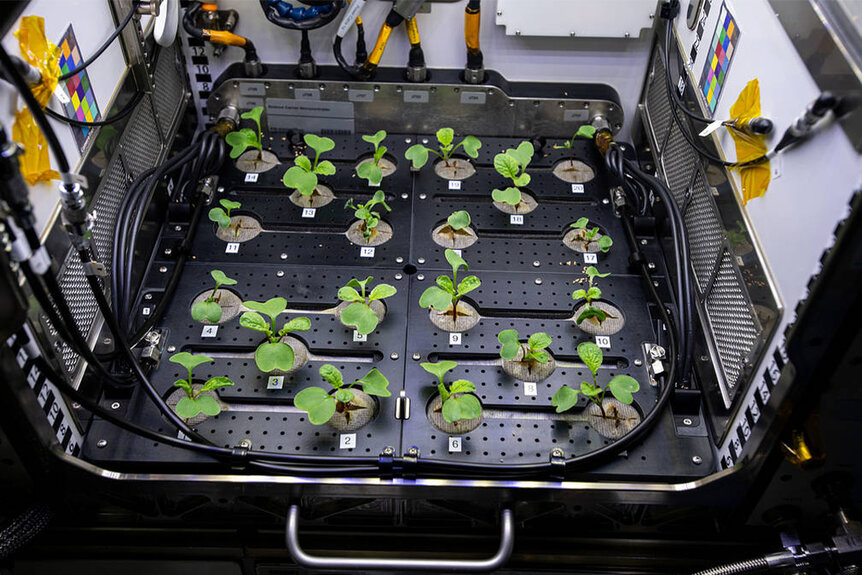Create a free profile to get unlimited access to exclusive videos, sweepstakes, and more!
Scientists develop optimal space salad to feed future astronauts
Our compliments to the chef.

Surviving in space for extended periods of time offers up some unique challenges. For short trips, we can get away with packing a sack lunch before we head off into the great unknown, comfortable in the knowledge that we’ll be back home before we get too hungry. For longer stints, we’re probably going to need to produce some essential materials, like food, in transit.
On The Ark (streaming now on Peacock!), SYFY's latest deep space adventure, astronauts solve this problem by growing food on the ship. While much of what we see onscreen is beyond our current technological ability, space farms aren't one of them. In fact, space agencies around the world are working right now to develop systems for growing food on other worlds or in the microgravity of interplanetary space.
RELATED: How do you make a spaceship? We asked the designer of Ark One from SYFY’s new series ‘The Ark’
The trick is figuring out the right combination of foods to meet a critical list of criteria. First, the chosen plants must be capable of growing in microgravity. They must also be capable of growing in non-natural circumstances. It’s likely that future astronauts will use a mixture of alien soil and hydroponics to deliver water and nutrients to planet-hopping plants. The research so far suggests that some plants might be better at that than others. Scientists also have to take into account the variable nutritional demands of life in space. The food pyramid needs a little shaking up as soon as you leave the planet. Finally, they need to do all of this while taking up as little space and as few resources as possible.
It’s a lot to ask of a salad, but an international team of researchers at the University of Adelaide in Australia and the University of Nottingham in the U.K. appear to have pulled it off. “We have simulated a mix of six to eight crops that deliver all of the required nutrients that an astronaut needs, which is different from what people on Earth need,” said University of Adelaide Professor Volker Hessel, in a statement.
The team used a 2011 NASA study which identified the nutritional needs of astronauts on long-duration space missions as their starting point. Then they considered more than a hundred plants, looking at things like the weight to calorie ratio, taste, and nutritional profile. They settled on a combination of soybean, poppy, barley, kale, peanuts, sweet potato, and sunflower seeds.
There are probably an infinite number of food combinations which could deliver the necessary nutrients and calories to traveling astronauts, but this combination manages to do it with the smallest serving size and the fewest number of ingredients. Simplifying the menu means we can pack more nutritional value into the same cargo space, potentially allowing for longer trips or larger crews than we could otherwise manage.
RELATED: New lunar farming technique puts us one step closer to growing food in space
All of that had to be accomplished with 10 ingredients or fewer, and for good reason. First, astronauts will have to prepare their meals without the benefit of gravity. A salad you can throw together with a handful of ingredients is easier to manage (especially while you’re busy keeping your spacecraft tip-top) than something with dozens of ingredients. Most importantly, astronauts will also have to grow all of that food before they can prepare it.
Too many different plant varieties with too many specific and often opposing needs unnecessarily complicates an already complex endeavor. Simpler is better. Now that we know what ingredients we need to keep astronauts happy, healthy, and fed, next steps will focus on developing the technologies and techniques to actually grow those plants aboard a spacecraft.
When you find yourself adrift in space, light years from the nearest planet, it’s nice to know you might at least get a last meal. Catch the latest episodes of The Ark, airing on SYFY Wednesdays at 10:00 p.m. ET, and streaming on Peacock the next day!















